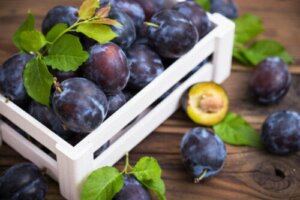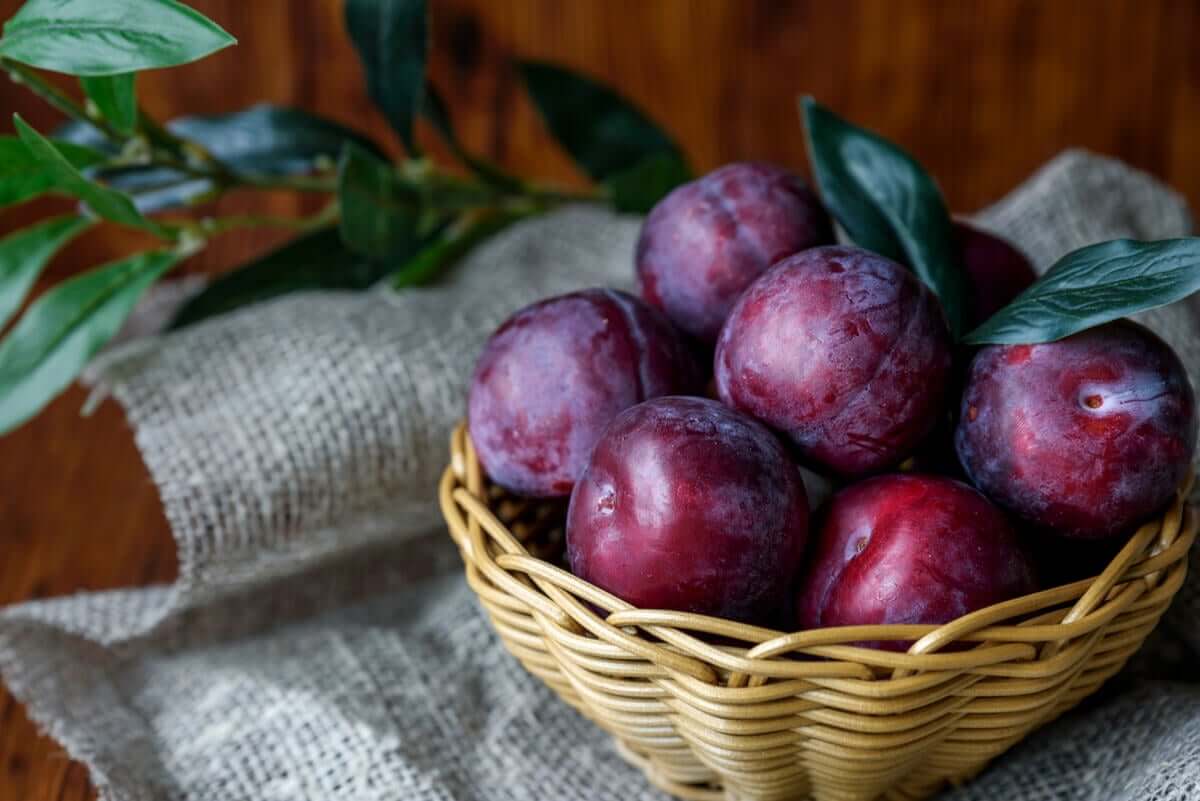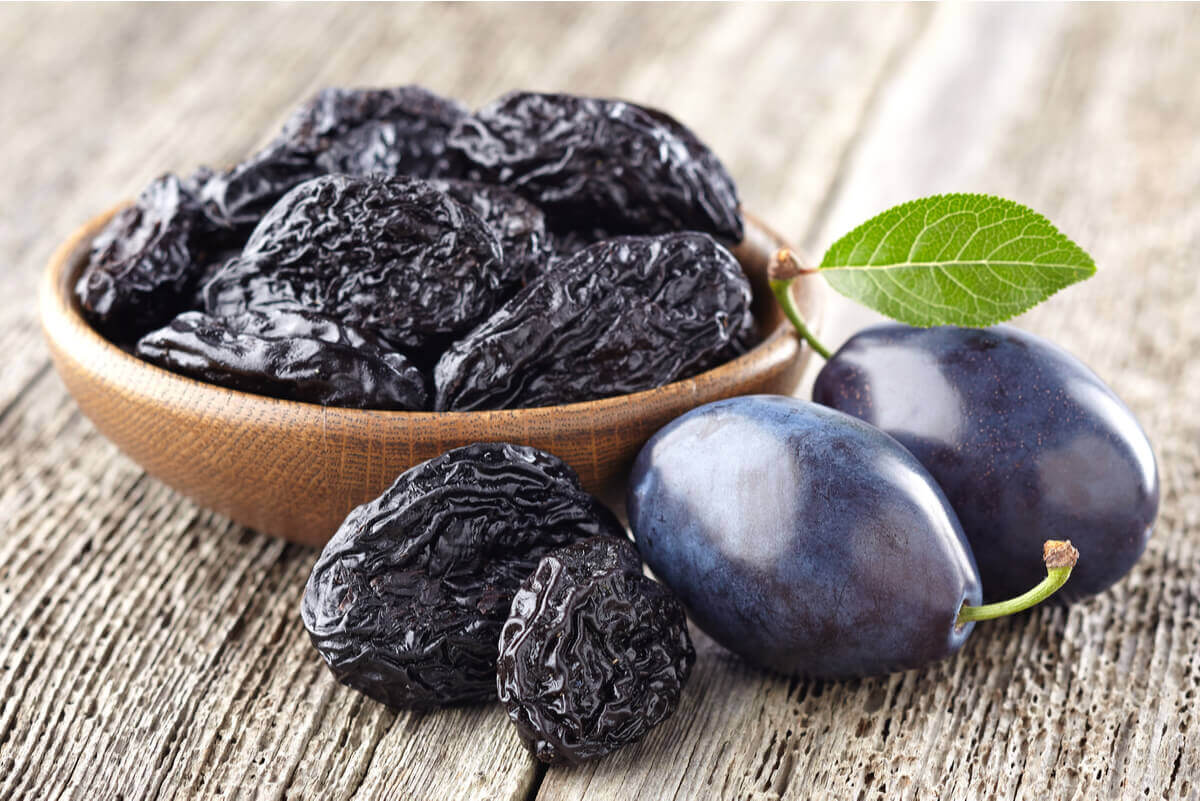Discover the Different Types and Varieties of Plums


Written and verified by the nutritionist Florencia Villafañe
Can you identify all the different types and varieties of plums?
Most people have eaten this fruit at some time. However, not everyone knows what the specific differences are between one type and another. With that in mind, this article will tell you more about this topic.
The plum is a fruit that has a particular flavor. It can be sweet or have an important degree of acidity. For this reason, there are those who are big fans plums. Besides that, they offer beneficial nutrients for the body, such as fiber, vitamins A, C and E, and minerals such as magnesium, zinc, and selenium.
The plum tree
This fruit comes from the plum tree, which is part of the Rosaceae family and belongs to the subgenus Prunus, just like the almond, cherry, and peach.
In general, this tree’s between about 16.5 or 19.55 feet high, has a smooth or cracked trunk and, in some species, branches with thorns. In addition, its leaves are elliptical with serrated edges and it has white flowers with buds that are rough to the touch. A point to highlight is that it can resist low temperatures and frost.
The fruits that this tree produce can be yellow, violet, red, white, or green. Inside, they have a juicy flesh with a firm consistency and a piet–an inedible seed. Outside, they have a smooth and soft skin. In general, yellow plums stand out for their acidity, those with red or violet tones are sweet, and the green ones are bitter.

Types of plums
According to the Argentine Surveillance and Pest Monitoring System, the best known types are the European and Japanese plums. These, in turn, present different varieties of plums. However, another form of classification may be by color.
We’ll provide more details below.
European plums (Prunus domestica)
The European plum tree is the most common. These fruits are usually light green (like the Claudia variety) or purple. They don’t contain a significant amount of water, so they’re useful for drying.
Of course you can also consume them as a fruit or use them to make sweets, compotes, jams, and preserves. They’re grown in France, England, Belgium, and Spain. Specifically, the varieties belonging to this group are Claudias, Stanley, President, Giant, and Ana Apath.
Japanese plums (Prunus salicina)
In general, we consume these plums fresh. They have reddish or black skin, although there are also light yellow varieties. They’re characteristic of warm climates. Within this type, we find the following varieties: Red Beauty, Golden Japan, Menthey, Formosa, Santa Rosa.
Yellow plum
This plum, which is native to the American continent and the West Indies goes by many different names. For example, the jobo, the yellow mombin, the hog plum, the gully plum, the coolie plum, or simply as the mope.
It’s small in size in comparison with others, has a firm pulp, and both the inside and outside are yellow in color. It’s used to make dessert cakes, jams, juices, fruit preserves, and plum brandy.
Read also: Benefits of Eating Fruit for Breakfast
The different varieties of plums
As already mentioned, there are different varieties of plums within these types. Below, we’ll give you more details about some of them.
Yellow Sungold Plum
This is a variety of Japanese plum that comes from South Africa, but grows in several countries. It’s large and aromatic, has yellow skin and, when it reaches maturity, can reach an intense red.
The pulp is yellow or orange and has a remarkable sweetness. You can eat it fresh, although it’s also useful for making jams.
Red Beauty Plum
This is another variety of Japanese plum that has a rounded shape. Its skin has a red color and can become dark, depending on how ripe it is. Inside it’s yellow and has a hard texture. Tor this reason, it’s useful for handling and transport.
Varieties of plums: Golden Japan Plum
This is a light yellow fruit with bright and resistant skin. It has juicy pulp and, like the previous ones, it’s also a Japanese variety. It’s generally cultivated in France, Italy, South Africa, and the United States.
Black Amber Plum
This fruit has black skin and a round, slightly flattened shape. The flesh is amber in color and firm. Due to its hardness, it’s resistant to handling. What’s more, it’s adapted to warm areas.
Varieties of plums: The Santa Rosa plum
This plum stands out for its rounded and heart-shaped shape. It has an intense red skin and inside it’s amber or light carmine yellow. In addition, its pulp is juicy and has a taste similar to that of strawberries.
Green Queen Claudia Plum
The Queen Claudia Plum is a variety of the European type plum. It has a medium size and is round. On the outside it’s green and it has a fine and juicy pulp. It’s ideal for eating fresh or using to prepare compotes, preserves, and jams.
See also: Relieve Constipation with this Plum, Fennel and Flax Seed Smoothie
Benefits of consuming different varieties of plums
According to several studies, the consumption of plums has beneficial effects on health. In particular, this is because they provide antioxidants, phytochemicals (a diverse group of compounds present in plants), vitamins, and minerals.
To make it clear, all these varieties of plums, despite having a different taste or color, can contribute to well-being. In this sense, the regular intake of this fruit contributes to the following:
- Improving the condition of skin and sight, thanks to its contribution of vitamin A.
- Preventing constipation: Plums improve digestion, due to the contribution of dietary fiber and sorbitol, its natural sweetener.
- Relieving fluid retention: Its high potassium content promotes the elimination of fluids so that they don’t accumulate in the soft tissues. This is favorable in people with high blood pressure.
- Maintaining cholesterol and blood sugar levels: This action is also mediated by fiber, which prevents high fat absorption.
- Strengthening the immune system: This is because plums provide vitamins and minerals that the body needs to function properly in terms of cell metabolism of white blood cells.

There are different types and varieties of plums for every taste
As you can see, there are many options of this fruit, besides the typical violet or red ones. Along with this, the flavor, the amount of water, and the contribution of nutrients that they contain can vary.
In spite of this health experts consider the consumption of any type or variety of plum to be beneficial to your health. The fiber will regulate your intestines, the minerals will help the immune system, and the potassium will contribute to the proper blood pressure levels.
All cited sources were thoroughly reviewed by our team to ensure their quality, reliability, currency, and validity. The bibliography of this article was considered reliable and of academic or scientific accuracy.
- Parra-Coronado, A., Hernández-Hernández, J. E., & Camacho-Tamayo, J. H. (2007). Estudio de algunas propiedades fisicas y fisiológicas precosecha de la ciruela variedad horvin. Revista Brasileira de Fruticultura, 29(3), 431-437.
- Vargas-Simón, G., Hernández-Cupil, R., & Moguel-Ordoñez, E. (2011). Caracterización morfológica de ciruela (Spondias purpurea L.) en tres municipios del estado de Tabasco, México. Bioagro, 23(2), 141-149.
- Caballero-Gutiérrez, L., & Gonzáles, G. F. (2016). Alimentos con efecto anti-inflamatorio. Acta Médica Peruana, 33(1), 50-64.
- Prunus domestica y P. salicina. Sistema de Vigilancia Argentino y monitoreo de plagas. Disponible en: https://www.sinavimo.gov.ar/cultivo/prunus-domestica-y-p-salicina.
- González-Flores, D., Velardo, B., Garrido, M., González-Gómez, D., Lozano, M., Ayuso, M. C., … & Rodríguez, A. B. (2011). Ingestion of Japanese plums (Prunus salicina Lindl. cv. Crimson Globe) increases the urinary 6-sulfatoxymelatonin and total antioxidant capacity levels in young, middle-aged and elderly humans: Nutritional and functional characterization of their content. Journal of Food & Nutrition Research, 50(4).
- Vilcanqui-Pérez, Fulgencio, and Carlos Vílchez-Perales. “Fibra dietaria: nuevas definiciones, propiedades funcionales y beneficios para la salud. Revisión.” Archivos Latinoamericanos de Nutrición 67.2 (2017): 146-156.
- Villanueva-Flores, Rafael Mauricio. “Fibra dietaria: una alternativa para la alimentación.” Ingeniería Industrial 037 (2019): 229-242.
- Ortega Anta, Rosa M., et al. “Pautas nutricionales en prevención y control de la hipertensión arterial.” Nutrición Hospitalaria 33 (2016): 53-58.
This text is provided for informational purposes only and does not replace consultation with a professional. If in doubt, consult your specialist.








